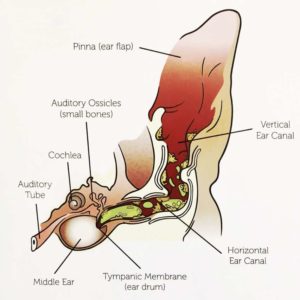Updated June 3, 2021
If your dog suffers from ear infections, then you need to know why they happen. And especially why they keep coming back.
I won’t dumb this down. I will do my best to keep it simple, but the reality of how ear infections happen is complex.
Please stick at it! What comes next may be hard going, but those who reach the end will know more than many professionals. They will also have a clear idea of why some treatments don’t work.
First, An Overview: The PSPP System
A better way of understanding the various drivers of ear infections is to divide them into four groups:
- Predisposing Factors
- Primary Causes
- Secondary Causes
- Perpetuating Factors
Not every dog will have all of these, but once an infection really gets going, they usually do. The observant will note that I’ve written them as PPSP, to put them in the rough order they happen to dogs. Now let’s dive deeper into each category.
1. Predisposing Factors
Predisposing factors are the things that affect the microclimate within the ear canal. They increase the risk of an ear infection, without causing problems on their own. These are the things you often see blamed for ear infections.
- Pendulous (floppy) ear flaps
- Excessive hair in ear canals
- Narrow ear canals
- Excessive cleaning or swimming
- Increased wax production
- Warm, humid weather
None of these causes an infection on its own, and many dogs get ear infections with none of these.
Clearly there’s a lot more to it. That’s why the next three categories are without a doubt more important.
2. Primary Causes
To get an infection, we also need to add a spark. Primary causes are the things that create inflammation of the ear canal and ear flap. They include:
- Skin diseases (atopic dermatitis, food allergy, hypersensitivity)
- Foreign bodies (especially grass seeds)
- Ear mites
- Hypothyroidism
- Ear canal tumours
Atopic dermatitis is very common and by far the most important. 55% of atopic dogs get ear infections, which can be the only sign of their problem. These are those dogs that seem to keep getting ear infections without a good reason.
3. Secondary Causes
So now we have an altered microclimate and inflammation. Conditions are ripe for a passing infection to take hold. This is usually a normal inhabitant of the canine skin, ready to take advantage of any weakness. Examples are:
- Bacteria (e.g. Staphylococcus, Pseudomonas)
- Yeast (especially Malassezia)
Once infection gets going, the whole thing ramps up a notch. Now there’s no going back. Unless the infection is properly and completely eliminated, it becomes like those bushfires that create their own weather.
What I mean is that the ear infection causes the ear canal to change in ways that help the problem not only to persist, but actually worsen. We call these…
4. Perpetuating Factors
Perpetuating factors are set up by the ear infection, and are probably the main reason for treatment failure. We are now in the classic vicious cycle of chronic otitis externa.
These changes include:
- Overgrowth of the ear canal lining and appearance of polyps
- Ear canal narrowing, thickening or calcification
- Wax gland overgrowth (especially Spaniels)
- Ear drum rupture
- Middle ear disease
- Destruction of the ear’s self cleaning mechanism

At the beginning you may not notice much, but perpetuating factors end up becoming the most severe part of ear infections. Everything they do acts to support the infection and make it harder to remove.
By now, eliminating the earlier causes has almost no effect on its own. That’s why an infection that’s been there a few months is always a lot harder to treat than one that’s only a few days old.
If this is your experience, it might all seem hopeless. But it’s not at all.
Treatment of Ear Infections
I see many, many ear infections that keep coming back. Once you understand why that is, success is just a matter of time, as long as you don’t give up.
There are only three reasons. You can probably guess by now what they are:
- Failure to treat the primary cause
- Failure to completely eliminate the infection
- Failure to recognise the perpetuating factors
Too many owners of dogs with ear infections don’t know about about the skin problem that’s right there too. A lot more don’t understand the importance of regular follow-up. And many others are battling away at a hopeless cause because they don’t realise the true extent of the problem.
All these are discussed in depth at the next part of the story: How To Treat A Dog’s Ear Infection
You might also like: Is There A Home Remedy For Dog Ear Infections?
Both articles coming next week.
Have something to add? Comments (if open) will appear within 24 hours.
By Andrew Spanner BVSc(Hons) MVetStud, a vet in Adelaide, Australia. Meet his team here.

Excellent information. Clear explanation and thorough information. Thank you!
What an amazing explanation of such a common problem. Can’t wait to read the next 2 articles! Thank you
Yes I am impressed too. Such a lot of information explained clearly and concisely and pitched at the right level for a problem that can be overwhelming and worrying for the average pet owner.